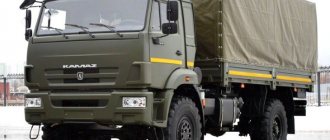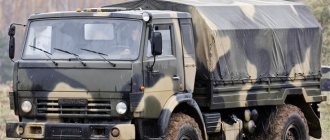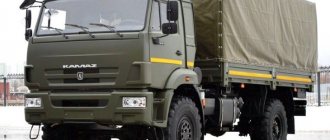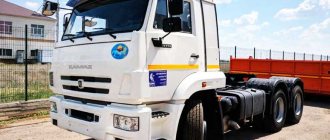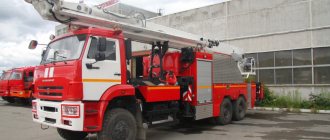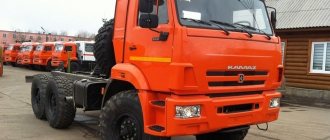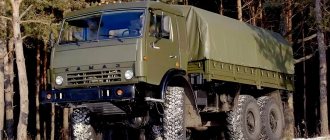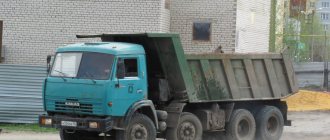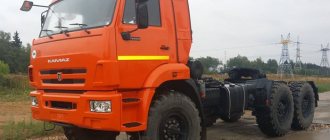KamAZ 4350 is an all-wheel drive truck with a 4 by 4 wheel arrangement. The development of equipment for transporting 30-40 people and the ability to operate in various conditions began back in the 1970s. However, the appearance of the Mustang line had to wait almost 30 years. Its first representative was the KamAZ 4326, which did not fully meet the army’s requirements, so it was soon replaced by other models with better maneuverability and cross-country ability.
The designers of the Kama Automobile Plant simultaneously developed 3 cars of the Mustang line: KamAZ 4350 (4 by 4), KamAZ 5350 (6 by 6) and KamAZ 6350 (8 by 8). These cars differed solely in the number of axles and had a high degree of unification (up to 85%).
The first prototypes were presented in 1990, their tests started a year later and turned out to be very successful. At the Kama Automobile Plant they were preparing to open serial production of the KamAZ 4350, but then there was a large-scale fire, which forced the suspension of the modification of the models. A new batch of testing machines was assembled only in 1995. At the same time, over the course of 5 years, the design of the car was noticeably altered. Thus, the chassis was modernized and a new 10-speed manual transmission was developed.
Serial production of KamAZ 4350 started in 2001. In 2007, the car’s engine line was updated (the model began to be equipped with a KamAZ-740.31-240 unit). Currently, production of the equipment continues. Most of the KamAZ 4350 produced is intended for military use.
Modifications
- KamAZ 4350 - standard variation with a load capacity of 4000 kg and a length of 7960 mm;
- KamAZ 43501 - military version with a shortened wheelbase (6395 mm) and a load capacity of 3000 kg;
- KamAZ 43501 VDV (KAMAZ 43501-0000399-02) - a special modification of KamAZ 43501, intended for airborne troops. The car replaced the obsolete GAZ 66, winning competition from the GAZ 3308 “Sadko”;
- KamAZ 43502 is a version of KamAZ 4350 with a KamAZ 740.652-260 unit (ecological class - Euro 4) and a load capacity of 5500 kg.
Special equipment based on KamAZ 4350:
- KamAZ-Barkhan - a modified model with a hood layout and a redesigned transmission;
- KamAZ 3958 “Highlander” is a special vehicle with an armored cab and an increased protection class;
- special equipment with radio stations (R-142N, R-142M, R-161).
Body
If we take into account the operating manual or catalog, the dump truck had a large welded all-steel body, which can be classified as a bucket type. It is also equipped with a special visor on the side of the cabin to provide additional protection. Experts decided to slightly widen the rear of the body to make it easier to unload bulk materials.
As an additional option, the body had a special heating system, which operated using exhaust gases. Moreover, it could prevent the cargo being transported from freezing during cold times. The lift of the dump truck body itself was quite high.
It was fixed in working order using locking pins, which were mounted on the bushings of the tipping brackets. They didn’t forget to install a specialized safety rope that prevented the body from tipping over.
With the help of a spring, it was possible to ensure that the safety rope was laid in the transport mechanism. The car was distinguished by the presence of a frame of increased strength. The welded subframe, which was made from cross beams and stamped steel spars, was connected using ties and brackets.
The dump hydraulic mechanism includes an oil drive, a power take-off, a control valve, a hydraulic cylinder, an oil tank, limit valves, a pneumatic drive, electric pneumatic valves and an oil pump. It takes no more than 20 seconds to raise or lower the body.
Specifications
Overall dimensions (KAMAZ 4350/KAMAZ 43501):
- length – 7960/6395 mm;
- width – 2550/2550 mm;
- height – 3290/3000 mm;
- ground clearance - 390 mm;
- loading height – 1570 mm;
- front track – 2050 mm;
- rear track – 2050 mm;
- turning radius – 10300 mm.
Base platform dimensions:
- length – 4890 mm;
- width – 2470 mm;
- height – 750 mm.
Weight characteristics (KAMAZ 4350/KAMAZ 43501):
- load capacity – 4000/3000 kg;
- curb weight – 7700/7100 kg;
- total weight – 11900/10300 kg;
- front axle load at full weight – 5300/5200 kg;
- rear axle load at full weight – 6600/5100 kg.
Passability indicators:
- ditch to be overcome – 600 mm;
- fordability – 1750 mm;
- climbability - 31 degrees.
The maximum speed of the car is 100 km/h.
KAMAZ 5511
At the end of the seventies of the last century, there was an acute shortage of heavy-duty dump trucks in the Soviet Union. The basis of the construction equipment fleet throughout the country was gasoline-powered vehicles. The country's leadership in those years set a course for converting equipment to diesel fuel. In order to create reliable diesel trucks, in 1976 the first stages of the Kama Automobile Plant (KAMAZ) were launched in Naberezhnye Chelny. The prototype of the first KAMAZ trucks was the prototype ZIL 170, the development of which was carried out at the Moscow Automobile Plant named after. Likhacheva. Due to organizational and technical reasons and to speed up the production process, the technical documentation of the ZIL 170 was transferred for revision to the Kama Automobile Plant. Serial production of the vehicles was established in a very short time, thanks in no small part to the availability of reliable diesel engines of our own design. The assembly of our own power units began back in 1975, and the first production KAMAZ 4320 was assembled in February 1976. Just three years later, the 100,000th truck rolled off the production line. The product range was constantly expanding. The model range consisted of flatbed vehicles, truck tractors, sports cars and special chassis. The first representative of dump trucks was KAMAZ 5511, the production of which began in 1977. The design of the machine turned out to be successful, and the dump truck itself is in demand in many sectors of the national economy. Its production lasted 13 years, and its modern modifications are still being produced today.
Article navigation
Engine
For the first modifications of the KamAZ 4350, an 8-cylinder V-shaped diesel unit was used, corresponding to the Euro-2 environmental class. The engine had a power of 240 hp.
The KamAZ 43501 was equipped with a KamAZ 740.11-240 engine that meets the requirements of the Euro-1 standard. The unit had closed-type liquid cooling, turbocharging and 8 cylinders (V-shaped arrangement, diameter - 120 mm). The power of the KamAZ 740.11-240 was 240 hp, the displacement was 10.85 liters, the maximum torque was 833 Nm, and the nominal speed was 2200 rpm.
Since 2007, KamAZ 43501 has been equipped with a new KamAZ 740.31-240 engine, corresponding to the Euro-2 environmental class. The engine is turbocharged and liquid cooled. The unit is more economical and provides a range of up to 1200 km.
Characteristics of KamAZ 740.31-240:
- working volume – 10.85 l;
- rated power - 240 hp;
- maximum torque – 932 Nm;
- compression ratio – 16.5;
- number of cylinders – 8 (V-shaped arrangement);
- cylinder diameter – 120 mm;
- average fuel consumption is 26.5 l/100 km.
KamAZ 4350 is equipped with 2 fuel tanks with a volume of 170 and 125 liters.
KamAZ-5511
- Car make: KamAZ
- Country of origin: USSR
- Year of manufacture: 1977
- Body type: Truck
KamAZ-5511 is a fairly popular model of a dump truck, produced by the Kama Automobile Enterprise. This car was produced for 13 years (1977-1990). The KamAZ 5511 dump truck served as one of the factory's first vehicles, but its use did not stop.
Even today you can quite often notice this brand on the roads of the Russian Federation, and not only that. The Soviet market did not previously have a large selection of dump trucks. This article is a description of the KamAZ-5511 dump truck. Here you can find out about the characteristics of KamAZ 5511. The entire KamAZ model range.
Device
KamAZ 4350 is the “junior” model of the Mustang series and has a 4 by 4 wheel arrangement. The front and rear suspensions are based on springs and are additionally equipped with anti-roll bars, which allow the vehicle to maintain control when driving on uneven roads. This feature is very important for military vehicles.
For equipment intended for the army, there are increased requirements for cross-country ability, therefore the KamAZ 4350 is equipped with a 5-speed manual transmission with a 3-code switching mechanism KamAZ 142 (5 forward speeds, 1 reverse speed). Modernization of the transmission made it possible to increase the service life by 15-20%. The car is also offered with a 10-speed manual transmission with a front splitter, which significantly increases the vehicle's cross-country ability.
Torque is transmitted from the engine to the gearbox using a dry friction single-plate clutch (pressure plate). Coil springs are installed peripherally, and the hydraulic clutch drive is equipped with a follower mechanism and a pneumatic-hydraulic booster. The rear axle has a 2-speed gearbox with a locking center differential and double final drive. The front axle has a non-disconnectable drive.
The service braking system includes a 2-circuit pneumatic drive that acts on the brake devices of the front and rear axles (separate action). The brake is controlled using a foot pedal located in the cab. To reduce speed and come to a complete stop, a backup brake system combined with a parking brake is used. The latter is equipped with an emergency brake release drive, which makes it possible to act on energy accumulators in the event of a compressed air leak. To activate the auxiliary braking system, an engine retarder is used, which closes the exhaust pipes and blocks the flow of fuel to the engine. There is a system of control devices in the cabin to monitor the operation of the brake systems.
A metal cabin with pneumatic seats and comfortable visibility has been developed for the KamAZ 4350. The chairs have several adjustments. The cabin design differs little from other models of the Kama Automobile Plant. In the cabin, in addition to heating and ventilation systems, there is space for a radio. The controls are located at a comfortable distance for the driver.
KamAZ 4350 can be equipped with a body or a booth with a various set of equipment, including a refrigerator, sink, safe and other appliances.
Car history
The beginning of the 1970s marked a “big construction project” in the USSR. Based on this, high-quality machines were needed that would be able to function for a long period of time, despite heavy loads. Therefore, they began to develop a model of a dump truck for construction sites. The car differed from similar models in that it had a bright yellow paint job that was non-standard for other domestic cars.
KamAZ-5511 has good cross-country ability, which makes it much higher than other trucks. The dump truck is not afraid of different climatic conditions, and with the help of the unloading mechanism it is possible to unload the cargo in a short period of time.
The truck was a durable three-axle structure with a 6x4 wheel arrangement. The KamAZ 5511 dump truck was distinguished by its increased load capacity, excellent maneuverability and versatility. Model 5511 was used for transporting a variety of cargo (which could include bulk cargo) on various road surfaces.
The presence of main parts and assemblies made it possible to unify them along with other parts of other products of the automobile plant in Naberezhnye Chelny. On top of that, this car was able to acquire the most modern technical layout of those times. For example, we can highlight the presence of headlights with an asymmetrical beam of illumination, which reduced the chance of oncoming cars being dazzled.
How often does the oil need to be changed?
It is recommended to change the oil in the KamAZ engine at least every 10,000–15,000 km of the truck. And if the color of the oil changes, this procedure must be performed immediately. There are other factors that force you to deviate from the instructions:
- Unfavorable conditions: harsh climate, bad roads, constant overloads affect the condition of lubricants, and most often, changing the engine oil is required earlier than the period established by the manufacturer.
- Poor quality fuel: affects the thermal conditions of the engine and provokes the formation of impurities in the oil.
- Vehicle service life: the older the KamAZ, the shorter the intervals between lubricant changes.
At KamRemCenter you can inexpensively buy a new or used engine for any KamAZ model and other spare parts.
Features and operation
For its time, KAMAZ 5511 was a fairly progressive vehicle. It was equipped with headlights with an asymmetrical beam of illumination, an alarm system, and a sprung driver's seat with seat belts. At construction and production sites, the car was easily recognized by the bright yellow color of the cab and body. All structural elements of the vehicle were attached to a reinforced frame, and access to the power plant was provided by raising the cabin by 42 and 60 degrees. A high level of safety was ensured by a reliable braking system. To ensure smooth braking and extend the service life of the brake linings, a gas-dynamic mechanism was installed in the exhaust manifold. To prevent freezing of transported bulk cargo at low temperatures, the car body was equipped with an exhaust gas heating system. The cabin was protected from cargo by a special metal canopy in the front part of the body. The body was insured against tipping over by a special cable with a spring, which ensured its placement in a transport configuration. The models of the first years of production were equipped with their own atmospheric diesel engines. Over time, they were replaced by turbocharged power plants of domestic and foreign production.
Oil movement in the Kamens lubrication system
From the oil pan, oil enters the oil pump through the intake pipe.
Next, the oil is supplied to the inlet of the oil cooler. In case of increased pressure, excess oil flows back into the pump (3.9 L and 5.9 L engines) or into the sump (4.5 L and 6.7 L engines). Next, the oil enters the filter inlet, the bypass valve of which opens if the pressure drop across the filter is above 345 kPa.
After being cleaned in the filter, the oil enters the lubrication system - the main line, the injector channel and the turbocharger line. The main oil line runs through the cylinder block near the fuel pump, where oil flows to the main bearings and crankshaft. From the main bearings there is a branch to the camshaft and piston cooling nozzles.
The second branch goes from the crankshaft to the connecting rod bearings. The third branching system runs from the main oil line vertically up the cylinder head gasket to the head itself. Next, the oil enters the valve mechanism, lubricating all its moving parts.
Basic properties of oils
Modern motor oils are made from mineral and synthetic base oils, have additive packages, and therefore have different viscosity and thermal oxidation parameters, and can operate under different temperature conditions and loads.
Basic oil requirements for 740 engines:
- Viscosity: the KamAZ engine requires oil with a high level of friction protection.
- Features of engine operation: must be no harsher than those specified by the engine oil manufacturer.
